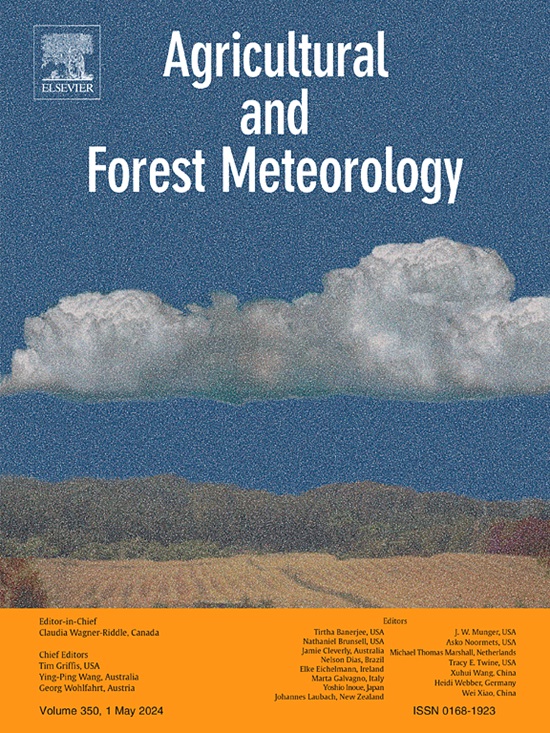Impact of pollution on the temperature sensitivity of multiple Norway spruce tree-ring parameters in Central Europe
IF 5.6
1区 农林科学
Q1 AGRONOMY
引用次数: 0
Abstract
Central European forests experienced high rates of air pollution in the second half of the 20th century, especially along the borders of Czechia, Germany and Poland. Consequently, tree-growth declines were detected in heavily polluted forests. However, information about how pollution has influenced growth-climate responses beyond tree-ring width (RW) in pollution-affected forests remains sparse. In this study, we investigated the impact of high-level pollution during 1960s-1980s in Central Europe on the climatic signals of various tree-ring parameters of Norway spruce, including RW, latewood Blue Intensity (LWBI), and maximum cell wall thickness (CWT), to understand how tree growth and climatic sensitivity were affected. Tree-ring cores were collected from six temperature-limited high-elevation sites within four pollution-affected regions in Czechia and northern Slovakia. RW and LWBI were measured for all samples and CWT was produced from two sites with contrasting pollution impacts. Distinct pollution-related RW growth suppression was detected in 1970s to 1980s at several sites. LWBI and CWT chronologies were highly correlated (r LWBI = 0.52–0.75; r CWT = 0.63–0.68) with growing season (April-September) temperature and did not exhibit clear signs of distortion by pollution compared to RW (r RW = 0.28–0.58). Pollution stress seemed to reduce tree growth by decreasing cell numbers and made RW less sensitive to climate. This study reveals that impacts of pollution on different tree-ring parameters varied which can further influence their climatic sensitivities. It provides valuable insight in improving the utility of pollution-affected tree-ring chronologies by choosing appropriate parameters, which can ultimately contribute to substantially improving the calibration of climate reconstructions from heavily polluted regions.
污染对中欧多个挪威云杉年轮参数温度敏感性的影响
中欧森林在20世纪下半叶经历了高度的空气污染,特别是在捷克、德国和波兰的边界。因此,在严重污染的森林中发现树木生长下降。然而,在受污染影响的森林中,污染如何影响树木年轮宽度(RW)以外的生长-气候响应的信息仍然很少。在本研究中,我们研究了20世纪60年代至80年代中欧高水平污染对挪威云杉各种树木年轮参数(包括RW、晚木蓝强度(LWBI)和最大细胞壁厚度(CWT))的气候信号的影响,以了解树木生长和气候敏感性是如何受到影响的。从捷克和斯洛伐克北部四个受污染影响地区的六个温度有限的高海拔地点收集了树木年轮核心。测量了所有样本的RW和LWBI,并从两个具有不同污染影响的地点产生CWT。在20世纪70年代至80年代,在几个地点发现了明显的污染相关的RW生长抑制。LWBI与CWT年表高度相关(r LWBI = 0.52-0.75;r CWT = 0.63-0.68)与生长季节(4 - 9月)温度有关,与RW相比,没有明显的污染扭曲迹象(r RW = 0.28-0.58)。污染胁迫似乎通过减少细胞数量来减少树木的生长,并使RW对气候的敏感性降低。研究表明,污染对不同树木年轮参数的影响存在差异,进而影响其气候敏感性。它通过选择合适的参数,为提高受污染影响的树木年轮年表的效用提供了有价值的见解,最终有助于大大改善重污染地区气候重建的校准。
本文章由计算机程序翻译,如有差异,请以英文原文为准。
求助全文
约1分钟内获得全文
求助全文
来源期刊
CiteScore
10.30
自引率
9.70%
发文量
415
审稿时长
69 days
期刊介绍:
Agricultural and Forest Meteorology is an international journal for the publication of original articles and reviews on the inter-relationship between meteorology, agriculture, forestry, and natural ecosystems. Emphasis is on basic and applied scientific research relevant to practical problems in the field of plant and soil sciences, ecology and biogeochemistry as affected by weather as well as climate variability and change. Theoretical models should be tested against experimental data. Articles must appeal to an international audience. Special issues devoted to single topics are also published.
Typical topics include canopy micrometeorology (e.g. canopy radiation transfer, turbulence near the ground, evapotranspiration, energy balance, fluxes of trace gases), micrometeorological instrumentation (e.g., sensors for trace gases, flux measurement instruments, radiation measurement techniques), aerobiology (e.g. the dispersion of pollen, spores, insects and pesticides), biometeorology (e.g. the effect of weather and climate on plant distribution, crop yield, water-use efficiency, and plant phenology), forest-fire/weather interactions, and feedbacks from vegetation to weather and the climate system.

 求助内容:
求助内容: 应助结果提醒方式:
应助结果提醒方式:


